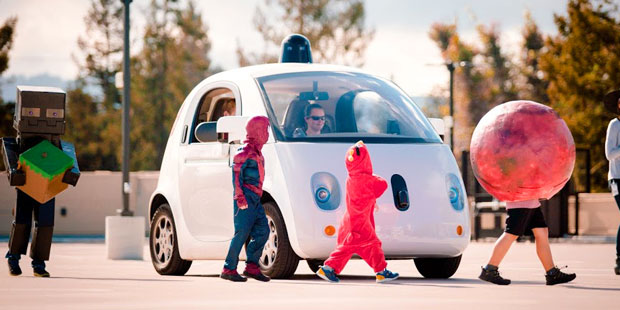The United States Patent and Trademark Office earlier this week granted Google a patent for “Adhesive Vehicle Front End For Mitigation of Secondary Pedestrian Impact.” The patent application, filed a year and a half ago, credits Google employees Alex Khaykin and Daniel Lynn Larner as the inventors of the new technology.
Larner contributed to several other Google patent applications, including one for an “Energy-absorbing apparatus,” filed in August 2014 and still pending; and one for “Devices and Methods for an Energy-Absorbing End of a Vehicle,” filed in May 2014 and granted in November 2015. Vehicular safety technology is a common theme in these patents.
This latest patent grant is for “a system for protecting a colliding object from a secondary impact, after an initial impact with a vehicle, including a vehicle having a front end.” The system includes an adhesive layer covered with a thin membrane that becomes exposed during a collision with an object, so that the colliding object will adhere to the vehicle.
In other words, this system is designed so that if a car were to hit a pedestrian, that person would in essence stick to the front of the car instead of being thrown forward.

Understanding the Principle
As a concept technology it sounds much like “people flypaper,” said Rob Enderle, principal analyst at the Enderle Group.
“The concept is a good one. When a person is hit, if you can keep them on the car the damage is limited to the initial contact — but if you don’t, the person is more likely to suffer additional damage,” he told TechNewsWorld. That could include injuries from falling off the vehicle and getting run over, for example.
There are some issues to work out, he suggested. If the outer shell were to fail, it could expose the adhesive, which could be difficult to clean.
“In addition, this likely wouldn’t age well,” Enderle speculated. “Adhesives of this type rarely do, and particularly after it got covered with other stuff stuck to it, getting it to then hold a person would be nearly impossible.”
Added Costs
Several manufacturers have created other systems to prevent injuries from a collision, the Google patent application notes. Certain Jaguar models feature a deployable hood designed to raise during an impact to provide a more compliant surface should a pedestrian be struck. Volvo has created an exterior airbag that deploys to lessen the severity of an impact to a pedestrian.
There have been few attempts to bring any such technology to the mass market, however.
“Companies aren’t really interested, as these features would add cost to their cars,” said Franco Gonzalez, senior technology analyst at IDTechEx.
The concepts would need much refining from a tech standpoint, but it isn’t all that likely such measures will be taken.
“Just because Google has filed a patent … doesn’t mean it will be implemented in a vehicle,” Gonzalez told TechNewsWorld. Many patents “never make it to the market, and this could very well be one of those cases.”
Autonomous Feature
Google’s patent application describes how the technology could be utilized with autonomous vehicles — something that the tech giant has been hard at work developing. It’s possible this technology could be intended as an added safety feature for testing of autonomous vehicles, but not make it into full production vehicles.
“Right now, Google has been testing its vehicles at low to medium speeds, but as the testing continues it may be seeking to add other safety measures, and this could be one of those,” said Gonzalez.
The technology could work with any car, but if implemented, it likely would require replacement of the adhesive-coated hood several times a year to ensure proper functioning, suggested Enderle.
“Coupled with the less-than-attractive idea of having super flypaper on the front of your car,” he said, “that makes this solution highly unlikely to be implemented by anyone that doesn’t want to showcase all the things they ran into that are now stuck to their hood.”























































